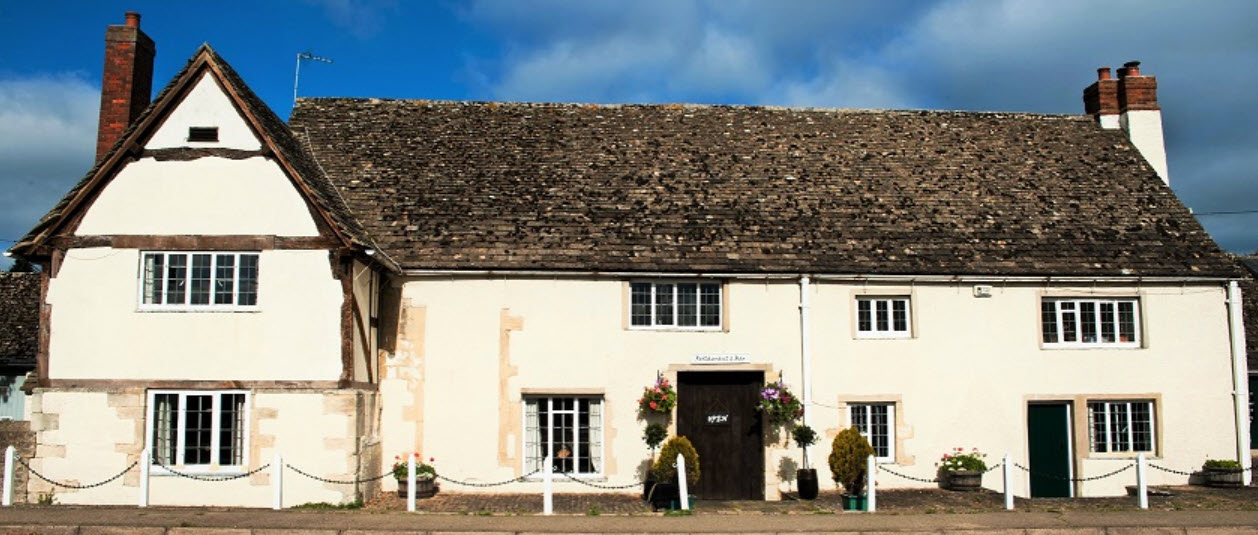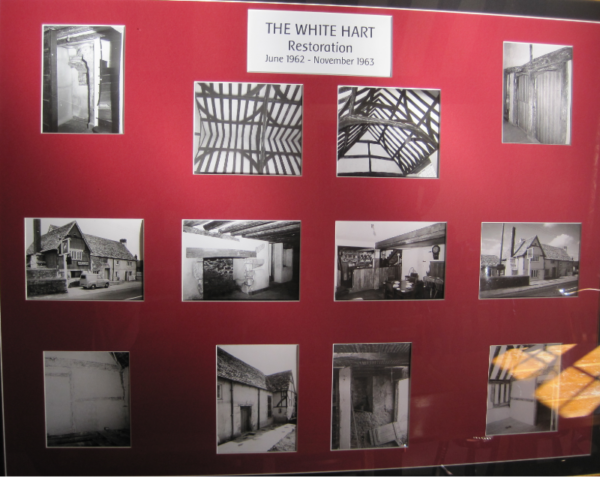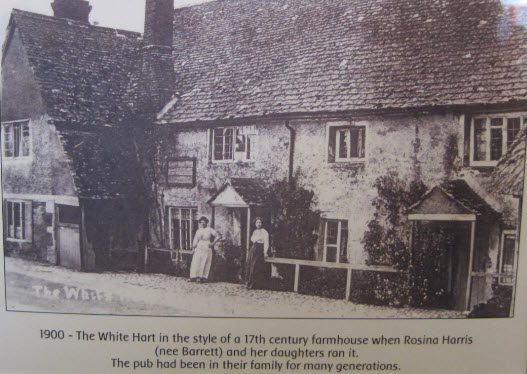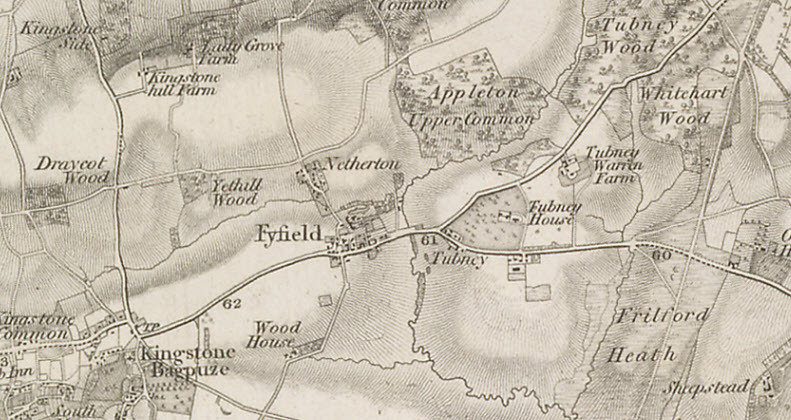Today, Main Road, Fyfield is a peaceful side road that allows villagers to access the busy A420 that has bypassed the village and speeds traffic on its way between Oxford and Swindon. To passing motorists, Fyfield is gone in the blink of an eye.
Most of the tiny village lies to the north of Main Road. The few streets are quiet and peaceful and Netherton Lane turns off from Main Road to take you to the heart of the village where the parish church of St Nicholas has stood since the late 12th century.
In the 19th century and earlier, the scene in Main Road would have been very different as it sat directly on the coaching route that preceded today’s modern highway, and the “commercial heart” of Fyfield – if such a phrase could be applied – would have been dominated by the wide frontage of the coaching inn that sits on Main Road.

The White Hart now presents itself as a charming old country pub/restaurant which serves outstanding cuisine, for which it has been awarded several prizes. There is a vegetable garden at the back which provides homegrown herbs and vegetables for the restaurant.
This same building started life as a 15th century Charter House built in the reign of Henry VI.
Sir John Golafre was Lord of the Manor in Fyfield, and when he died in 1442, he left instruction and finance to build a charitable establishment, a Chantry, to be known as The Hospital of St. John the Baptist.
In 1548, Henry VIII abolished all the Chantries and confiscated their properties, including the Fyfield Chantry. In 1558, after being sold, it became the property of St, John’s College, Oxford, which already owned much property in the area. It was at this time that the building became a public house, being leased to tenants by the College.
 The building that was erected after Sir John’s death still stands today, although it has had a few renovations. The old kitchen is now the bar and the ‘priest’s lower room’ is now the restaurant.
The building that was erected after Sir John’s death still stands today, although it has had a few renovations. The old kitchen is now the bar and the ‘priest’s lower room’ is now the restaurant.
Our family has a connection with The White Hart as our 4 x great-grandfather, John Barrett (1811 – 1868) was a tenant wheelwright and publican. Found in the Post Office Gazette of 1848, which describes Fyfield at that time, is an entry under “Trades” which describes John Barrett as landlord of The White Hart.
In the large area behind the pub, it is easy to imagine stables there and room for horse drawn coaches to turn. John would have repaired the coaches and wheels and together with the rest of his family, offered food and shelter. By the end of the 19th century and the arrival of the 20th century, wheelwrights were not needed so much. Those with carpenter skills fared better.
It is probable that John’s father, Richard Barrett (1782-1828) was also a tenant. There is no evidence that there were any Barretts there before Richard and John.
John Barrett married Harriet Alder on November 16th 1831 at St. Nicholas’ Church, Fyfield. They had twelve children which is not unusual for that time, but it is hard to imagine a family of that size being brought up in that space! John had six sons who were also carpenters/wheelwrights.
- Richard (child 1: 1832-1882) became a wheelwright and publican at The Lamb and Flag, Faringdon Road, Longworth.
- Henry (child 2: 1833-1907) – it seems he was also a general labourer when there was no work as a wheelwright.
- William (child 3: 1834-1908) was a carpenter but also employed at Warren Farm, Tubney.
- James Augustus (child 4: 1836-1909) was a Postmaster and a carpenter. Found on the 1891 census, living at 85 Main Street, Fyfield. By 1901 he was living at the Post Office in Fyfield village.
- Albert John (child 9: 1843-1899) a carpenter and innkeeper at The Doghouse, North Street, Marcham. Imagine being in the Doghouse for a living!
- Ferberd (child 11) was a carpenter and a labourer and lived in Tubney and Fyfield during his lifetime. It is Ferberd from whom we are descended. Yes, Ferberd is a peculiar name. This is the first time it was used in the family. We think he might have been given the name as the local doctor (no relation) was one Ferberd Sessions Barrett. Maybe they were running out of boy’s names by then!
According to the 1861 census, our Ferberd worked as a stable lad to Doctor Barrett, who also had a son by the name of Ferberd, born in 1829. It was used in our family about four times in further generations, usually with Henry as a second name and once the name skipped to an uncle before coming back into the direct line. Uncle Ferberd (1876-1943) was a groom at Penryhn Castle, near Colwyn Bay, North Wales.
My father was Ferberd Henry (1923-2003). He was the last to have Ferberd as a first name. My brother, Paul, one of the Society’s webmasters, has it as a middle name but it has not progressed to the next two generations. After much research, we believe the name Ferberd is a corruption of ‘Fairbeard’.
Of John and Harriett’s daughters, two died quite young, Emma Anne (child 5: 1837-1851) and Mary Victoria (child 10: 1845-1851). How sad that they both died in the same year.
There were four more daughters:
- Elizabeth (child 6: 1838-1913) married John Parker and Jane (child 8: 1841-1926) married Frederick White.
- Ellen (child 12: 1848-1922) was a beer housekeeper at the Bakers’ Arms, Great Faringdon. She married George Barnard in 1868 but was widowed in 1880. She later married Charles Pike and moved to London.
- Rosina Barrett (child 7: 1840-1917), our 3 x great aunt, married John Thomas Harris, also a publican and they were the next tenants of The White Hart.
- After John Harris’ death in 1888, she was a publican ‘under her own account’ as described by one census. She ran The White Hart with her daughters until her death in 1917 and her tenancy is commemorated in this picture which hangs in the pub to this day.

We do not know who had tenancy of the pub after that, maybe the 1921 census will tell us.
The present incumbents are Mark and Kay Chandler, which just adds to the interest because our paternal great grandmother was Mary Ann Chandler*.

This work is based on data provided through www.VisionofBritain.org.uk and uses historical material which is copyright of the Great Britain Historical GIS Project and the University of Portsmouth
It was our father, Ferberd Henry Barrett, who started the family history research in the 1960s, mainly to discover the origin of his strange name.
He was a strict churchgoer who hated going into pubs and we suspect he would have been mortified to learn how many of his ancestors not only frequented but also managed them. His children and grandchildren have no objection to going into pubs!
* In fact, the possible familial link with the current landlord clearly demanded that extensive field research be carried out! Following this extensive field research, we have discovered there is no link!
If any of the descendants of the people named above would like to contact us, we would be happy to hear from you.
You’ll find our family tree at https://ourfamilyhistory.club and Paul and I belong to the Society forum so we’re happy to meet you there.
